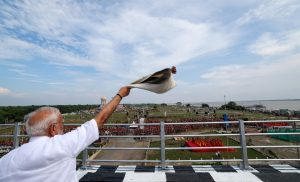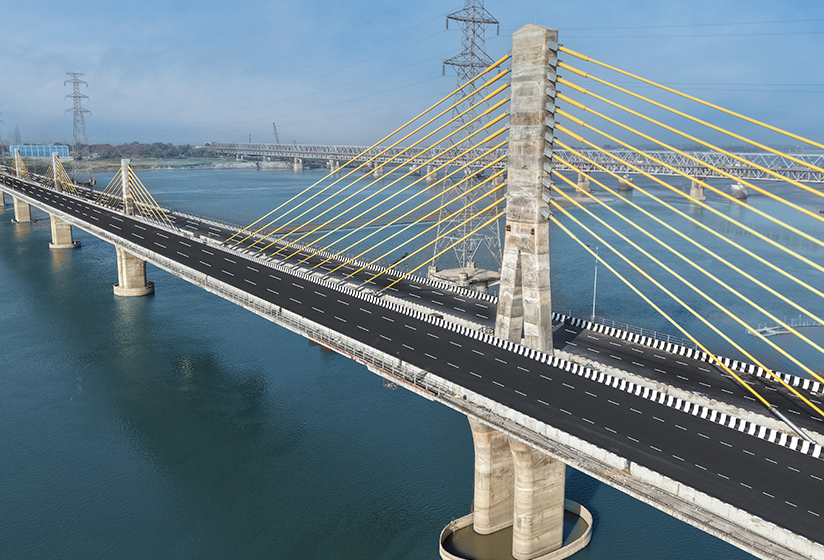The new bridge will eliminate the need for heavy vehicles to take detours of over 100 kms between North Bihar districts, easing regional traffic congestion, particularly in areas previously strained by diverted freight movement.
Prime Minister Narendra Modi inaugurated the ₹18.7 billion Aunta-Simaria Ganga Bridge Project on Friday, part of a broader ₹120 billion infrastructure rollout in Gaya, Bihar. The six-lane bridge, spanning the River Ganga, is designed to connect Mokama in Patna district with Simaria in Begusarai, significantly improving regional connectivity and reducing travel time by over an hour.
Greeting the public from the city of the famed Vishnupad Temple, Modi said, “Gaya ji’s spiritual and cultural heritage is both ancient and immensely rich.”
He added, “The rapid development of Bihar is a major priority for the NDA government at the centre,” noting that longstanding challenges are being resolved and new avenues for progress are opening.
“From the sacred land of Gaya ji, projects worth ₹120 billion have been inaugurated and foundation stones laid in a single day,” he said, referring to initiatives across energy, healthcare, and urban development aimed at boosting industrial capacity and youth employment.
Modi recalled laying the foundation stone for the Aunta-Simaria section and now inaugurating it himself.
“This bridge will not only connect roads but will also link North and South Bihar,” he said. “Heavy vehicles, which earlier had to take a 150-kilometre detour via Gandhi Setu, will now have a direct route. This will accelerate trade, strengthen industries, and make travel easier for pilgrims.”
The new bridge will eliminate the need for heavy vehicles to take a detour of over 100 kilometres when travelling between North Bihar districts such as Begusarai, Supaul, Madhubani, Purnea and Araria, and South Bihar regions including Sheikhpura, Nawada and Lakhisarai. This direct connectivity is expected to ease traffic congestion across the region, particularly in areas previously burdened by diverted freight movement.
By streamlining logistics, the bridge will catalyse economic growth in adjoining districts, especially in North Bihar, which relies on South Bihar and Jharkhand for essential raw materials. It will also enhance access to Simaria Dham, a revered pilgrimage site and the birthplace of renowned poet Late Ramdhari Singh Dinkar, further strengthening cultural and spiritual ties across the state.

Engineering and Environmental Innovation
The 8.15-kilometre project includes a 1.86-kilometre six-lane bridge over the Ganga, with segment spans ranging from 57 to 115 metres and cantilever arms extending up to 70 metres. Built to support heavy vehicular loads, it offers a modern alternative to the ageing Rajendra Setu Bridge nearby.
Developed by Welspun Enterprises Ltd (WEL), the infrastructure arm of Welspun World, in partnership with the Bihar government and the National Highways Authority of India (NHAI), the project overcame significant engineering and environmental challenges. These included strong river currents, high water tables, soft riverbed soil, and complex social dynamics.
A standout achievement was the use of box pushing technology to construct a Railway Under Bridge with minimal disruption. For the first time in India, a single-cell box measuring 24 metres in length was pushed under a railway line, marking a major engineering milestone.
BK Goenka, Chairman, Welspun World, said, “This project is a true embodiment of our vision to build nation-critical infrastructure that transforms regions and enhances livelihoods. We are proud to have delivered a bridge that is not only an engineering marvel but also a lifeline for Bihar and beyond.”
Sandeep Garg, Managing Director, Welspun Enterprises, added, “The Aunta-Simaria Ganga Bridge Project showcases Welspun Enterprises’ engineering excellence and execution capabilities in some of the most challenging environments. From innovative construction techniques to seamless stakeholder coordination, it has set a new benchmark for infrastructure delivery in India.”
To safeguard the Ganga ecosystem, the project team adopted smart water management practices, including the use of superplasticisers to reduce water in concrete mixes and curing compounds to minimise water use during curing. Circular material use was promoted by incorporating pond ash in embankments instead of natural soil. Construction innovations such as precast elements and high-performance concrete with silica fume enhanced both efficiency and sustainability.


